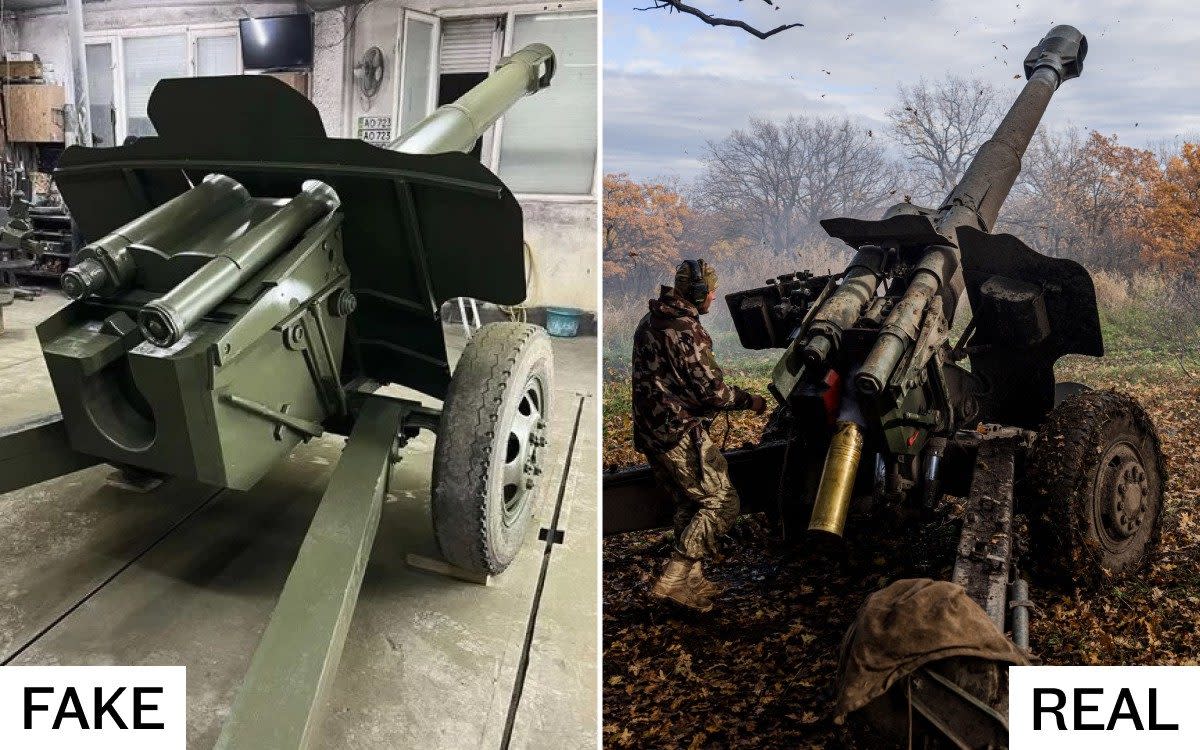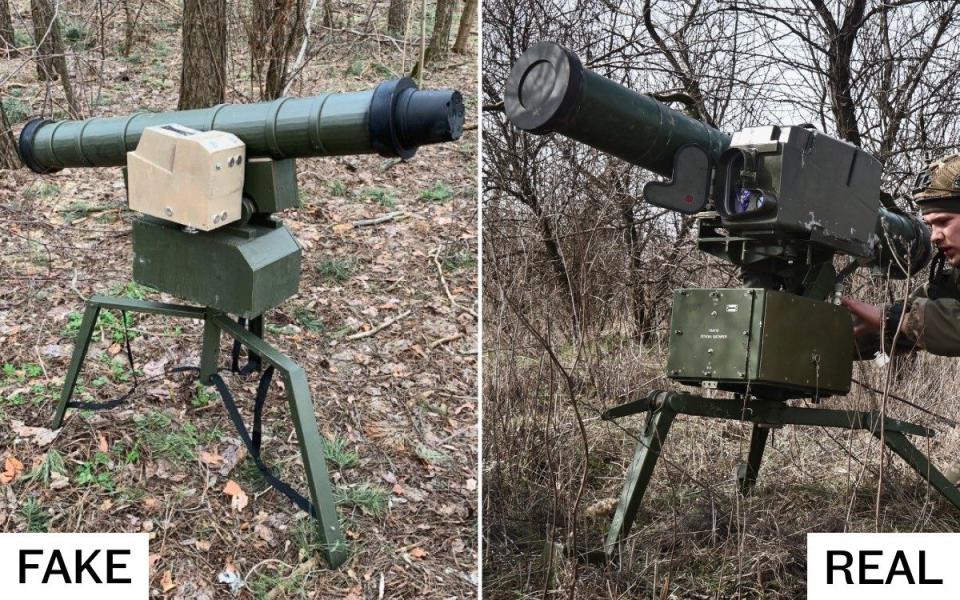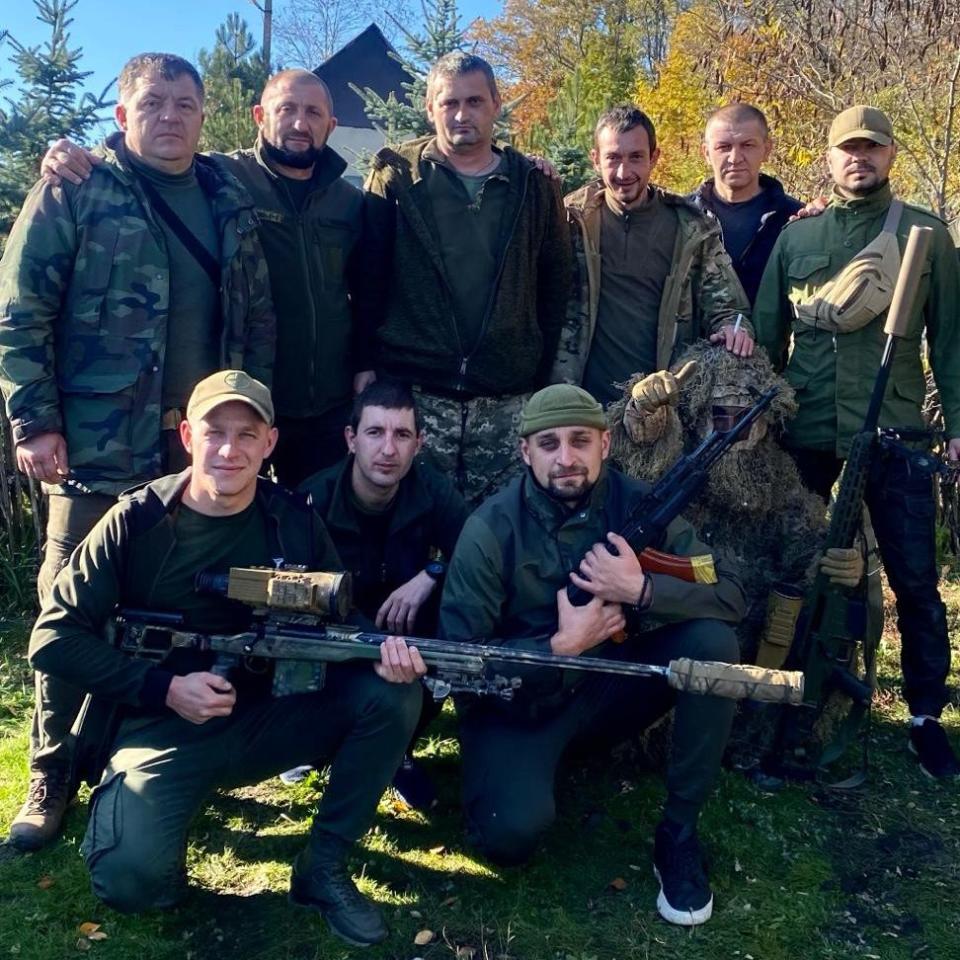Ukraine builds decoy weapons out of drainpipes to divert Russian attacks

Demand for fake weaponry has shot up as Ukrainian troops on the front line contend with increasing Russian strikes and dwindling supplies.
Mykhailo Roman, 32, an architect who produces dummy weapons out of plywood, metal and plastic drainpipe, said he has been working overtime in recent months.
The married father-of-one runs a small architecture firm in Vynohradiv, a village just 10 miles from the Hungarian border in south-west Ukraine that is largely untouched by the ravages of war.
By day, he mostly designs houses. But in his evenings, he has turned his skills to building a Potemkin army.
Tinkering away in a secret warehouse, the location of which he cannot disclose, Mr Roman and a group of volunteers build life-size models of missile launchers and artillery guns, designed to dupe Russia into wasting ammunition on destroying fake targets.
His team strives to make the models as “realistic and cheap as possible”. Everything lying around the workshop is used: foam blocks, used tyres, scrap wood, sheet metal and plastic tubes.
It comes as Ukraine’s top commander admitted that Russian forces fighting in eastern Ukraine have recently had six times more ammunition to fire than Kyiv’s troops.
Gen Oleksandr Syrskyi said in his first interview since being appointed commander-in-chief of the Ukrainian military last month: “The enemy conducts dense artillery and mortar fire. Until a few days ago, the enemy’s advantage in terms of ammunition fired was about six to one.”
He also said Ukrainian forces were learning to adapt and fight with limited ammunition and soldiers but that plans to recruit another 500,000 soldiers had been downgraded.
Over the past year, Mr Roman’s team has built more than 200 dummy Stugna anti-tank guided missile launchers and two D-20 howitzer artillery guns, which have been deployed across Ukraine’s front lines from Orikhiv in the south, to Donetsk and Lyman in the east, as well as Kharkiv and Sumy to the north.
The first imitation missile launcher took two months to design and cost about 3,000-4,000 hryvnia (£60-80). Since then, he has fine-tuned the manufacturing process, knocking them out in a matter of days and slashing the price to just 1,000 hryvnia – a fraction of the estimated £790 cost of a Russian artillery shell.

Mr Roman proudly posts footage on social media sent to him by Ukrainian troops of his replica weapons in action at the front.
In one video, a soldier can be heard saying: “Look how the Russians strike, the morons,” while demonstrating the damage caused to the decoys by a barrage of Russian shells. “Twenty rounds per strike; $20,000 [£15,850] for each Stugna made by you guys,” he added.
Made up of three components – a tripod, a barrel and a computer – the dummy launchers are now produced in flat-pack form which soldiers can assemble in a matter of minutes. “It can be sent by post – we deliver,” Mr Roman said, cracking a wry smile.

The success of Mr Roman’s team is measured by the number of their decoy weapons that are destroyed. “When they destroy them, it makes me want to build more,” he said.
They also have a practical benefit, helping to direct Ukraine’s strikes. “When Russian soldiers have destroyed these models, our military forces can see their positions and attack them,” he said.
The spike in Mr Roman’s recent production comes amid reports of an acute shell shortage on the front line as a US package of aid worth an estimated $60 billion remains tied up in Congress.
Asked whether fake weaponry could provide a short-term solution to delays in Western aid, Mr Roman is clear in his response.
‘Exhaust the enemy’
“The main idea of these models is to exhaust the enemy and to see their position,” he said. “We need real weapons because we can win the war only with real weapons.”
In recent weeks, he has received commissions to design more complex models, including a custom order for his most advanced project yet: a dummy Patriot missile system.
The US-made mobile surface-to-air missile defence system is considered one of the most advanced air defence systems in the world and is in huge demand in Ukraine.
The real thing costs around $1 billion, plus another $1billion or so for the software and the missiles.
Mr Roman says he can make a fake one for around $10,000. The hope is that it attracts the attention of Moscow and its $3million-a-pop Iskander cruise missiles.
“The fake patriot will be placed a big distance from the front line so only Iskander will see it and could destroy it,” he said.

He is also building a fake D-20 howitzer gun, replete with tractor wheels to deal with the boggy front-line terrain. “It looks like a huge wagon on wheels,” he said.
Based on photos and videos of the artillery gun taken on the front lines, Mr Roman’s imitation cost about 20,000 hryvnias and took his team of 20 carpenters, architects and builders two months to complete.
After delivering the first artillery gun to the front lines a couple of weeks ago, he received messages from five other units asking for their own versions. “We are going to try to make it quicker,” he said. “We could do it in a week if needed.”
On top of weapons, Mr Roman has also begun work on a fleet of imitation Starlink satellite terminals, recreating the white dishes that Kyiv relies on for internet connection to wage its drone war against Russia’s Black Sea fleet.
He plans for the decoy terminals to be positioned in the vicinity of a real terminal in order to confuse any surveillance or potential attacks.
Dummy weapons have been deployed in the theatre of war throughout human history, from the Trojan horse to decoy tanks made out of palm-fronds at El Alamein and Churchill’s construction of a fictitious D-Day landing fleet under Operation Fortitude South.
Fake arms race
In the Ukraine war, military deception has reached new heights amid reports of inflatable tanks, wooden Himars and Ukraine draping giant pictures of blown-up hangars on sheets over their airbases to dupe passing Russian pilots into thinking they have already been destroyed.
Mr Roman has been delivering aid to soldiers on Ukraine’s front lines since 2014, following Russia’s annexation of Crimea. It was during one of these excursions last year, when he saw front-line soldiers designing their own replica weapons out of scrap material, that he decided to try it out himself.
Over the past year, Mr Roman’s designs have spawned a fake arms race of sorts, in which the better Russian forces become at spotting his replicas, the more advanced his designs have become.
“We are winning this race, he said. Because they have a lot of missiles, and they are using them,” he said. “They do not care about where to shoot them, so we are exhausting the enemy.”


